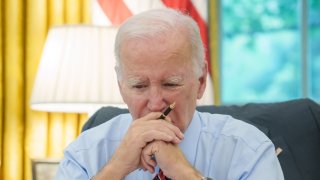2024: The Year America Has a Full-Blown Financial Crisis?
By continuing to inflict significant losses on the banks’ balance sheets through higher interest rates, the Fed seems to be inviting a full-blown financial crisis before the middle of next year.
A credit cycle is a normal process in a market economy. However, today’s U.S. credit cycle is anything but normal. Not only was its easy phase fueled by the loosest monetary policy in the postwar period. Its tightening phase is being reinforced by a spike in long-term US Treasury bond yields and a crisis in the commercial real estate sector. That combination now sets us up for a hard economic landing by the middle of next year.
Hyman Minsky, the late credit cycle expert, explained that easy monetary policy generally leads to complacency in the financial system and to irresponsible bank lending. When the music of easy money stops playing, we discover who has been swimming naked. That leads to a wave of defaults that causes real strain in the financial system.
The easy part of the current US credit cycle has been unusually easy, thanks to the Federal Reserve’s excessive money printing activity. In response to the 2020 Covid-induced economic recession, the Fed cut its interest rates to its zero lower-bound. At the same time, it flooded the market with more than $ 4 trillion in liquidity through its quantitative easing program.
In the process, the Fed allowed the broad money supply to increase by 40 percent from the beginning of 2020 to the end of 2021. That encouraged reckless lending at very low-interest rates that did not nearly compensate lenders for the risk that the borrowers might default on their loans.
At the start of last year, the music of easy money policy stopped playing abruptly when the Fed was forced to slam hard on the monetary policy brakes. It had to do so to regain control over inflation that had surged to a multi-decade high of 9 percent. In the short space of 18 months, the Fed raised interest rates by 525 basis points or at the fastest pace in the post-war period. At the same time, the Fed shifted from a policy of flooding the market with $120 billion a month in liquidity through quantitative easing to one of draining $95 billion a month through quantitative tightening.
The Fed’s newfound monetary policy religion severely damaged the banking system’s large bond portfolios. It did so by causing a large decline in Treasury bond prices. That, in turn, led to the failure earlier this year of Silicon Valley Bank and First National Bank, the second and third largest US bank failures on record.
One factor increasing the chances that we are well on the way to another round of the regional bank crisis is the recent spike in Treasury bond yields as markets have begun to fret over the fact that the government is running an 8 percent of GDP budget deficit at a time of cyclical strength. Over the past two months, the 10-year Treasury bond yield has jumped from 4 percent to 5 percent.
Even before the recent jump in yields, it was estimated that the US banking system had $620 billion in mark-to-market losses on its Treasury bond portfolio. The latest fall in Treasury bond prices will only add to those losses.
Another factor that heightens the chances of a new round in the banking sector crisis is the expected wave of defaults on commercial real estate loans. With office occupancy rates unusually low in a post-Covid world, it is difficult to see how property developers will manage to roll over at higher interest rates the $500 billion in property loans falling due next year. This could be particularly problematic for the regional banks, with as much as 18 percent of their balance sheets exposed to commercial real estate lending.
This has to raise questions about the Fed’s current mantra of high interest rates for longer. It also has to raise doubt about the wisdom of its policy of withdrawing $95 billion a month in market liquidity at a time when the Treasury is having trouble financing itself at reasonable interest rates. By continuing to inflict significant losses on the banks’ balance sheets through higher interest rates, the Fed seems to be inviting a full-blown financial crisis before the middle of next year.
American Enterprise Institute senior fellow Desmond Lachman was a deputy director in the International Monetary Fund’s Policy Development and Review Department and the chief emerging-market economic strategist at Salomon Smith Barney.
Image Credit: Creative Commons.

